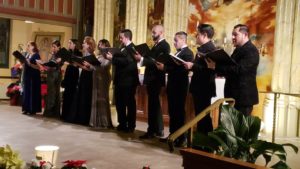
Puntaclassic 2018 Review: El Rey Nacio
Despite Bumps, Artists Tread New Ground with Re-Telling of Nativity Story
By Logan MartellOn December 8, 2018, audiences gathered in St. Brigid – Saint Emeric Church to hear the story of Christ birth in a slightly different way: through opera.
“El Rey Nacio,” by composer Jose Luis Gonzalez Moya, bills itself as the “first opera composed about the birth of Jesus,” and this structure serves the miraculous nature of the narrative in highly interesting ways.
Structural Challenges
The concert staging of this work was broken into 19 musical numbers, most of which were preceded by a short reading from the Gospels which laid out the setting and events of the number to follow. While useful in keeping the plot oriented, the readings themselves became rather drawn-out, and highly reminiscent of a church’s Christmas pageant, rather than an opera; it didn’t help that while the music was sung in Spanish, the Gospel readings were in English. This dragging feeling was compounded by the unevenness of the acts, with seven numbers making up the first act, 12 numbers making up the second, and no intermission between them.
The work opened with an overture played by a piano and single violin; a slowly rising melody being joined by a chorus to set the stage for a confrontation between a figure robed in black, and one robed in white. The figure in white prevailed, banishing the ostensible evil with a burst of sound and lasers as the tumult of the overture came to a strong resolution. While undeniably a striking manner to start the work, it was completely inconsistent with the remainder of the presentation; this decision established expectations for the audience that the direction of the production would be unable to meet for the next 90 minutes or so.
It would be interesting to see the work in a true staging, with intermission, and in one consistent language.
Spotlight On The Overlooked
While “El Ray Nacio” visits the more familiar parts of the Biblical account, it also explores moments that tend to be glossed over; this adds a needed sense of drama to a story where the protagonist is the Mother of Christ.
An early example of this came in the second number, “Confrontacion/Magnificat,” which saw an impassioned argument between Joseph and Barabbas’ Father as the latter demanded Mary’s stoning for alleged adultery. The faster rhythm of their exchanges was broken by the calmer chords of Mary’s passages before the debate would begin again from the top.
After an aria that follows Joseph coming to terms with supporting Mary as a husband, and an aria of reassurance when he is visited by an angel, the first act ends with a fitting ensemble number “Revelation to the Shepherds,” which saw the cast gathered to express awe over the coming birth of Christ.
Vocal Prowess Abounds
As Mary, Luz del Alba Rubio was often the center of attention, and her vocality demonstrated her ability to carry the work forward. In her earlier numbers, Rubio showed herself able to glide almost effortlessly into the highest reaches of her voice.
In the role of Joseph, baritone Gerardo De la Torre made a faithful partner to Mary both dramatically and vocally. This certainty came to fruition with his aria “Temor hay en mi corazón,” which began with brooding, conflicted phrases. Between De la Torre’s passionate delivery and the strength of the piano accompaniment, the single violin was nearly inaudible until the aria reached a much softer dynamic.
While King Herod does not appear in this opera, the role of antagonist goes to the Father of Barabbas, played by baritone Miguel Angel Vasquez. His ardent baritone and strong dramatic presence were felt throughout the evening’s performance. His early trio with Joseph and Mary was immediately followed by the harsh ensemble number “wedding or stoning,” in reference to the ultimatum he poses to Mary. The brazen, driving rhythm suited the clamor coming from the men’s chorus; all of this built towards a rowdy and oppressive finish.
As the Angel, soprano Cristina Gonzalez’s gentleness made her well-suited to the role. As she appears to bring tidings to Joseph, her soft phrases had a spoken quality which, while charming, did not seem to carry all that far. As Gonzalez floated her way to the higher reaches of her voice, her shining soprano unfolded beautiful and resonant. Gonzalez also led the ensemble number which closed the first act, with much of the ensemble quickly piling on like a growing clamor after the beginnings of phrases.
Rounding out the sopranos of this work were Eugenia Forteza as the Shepherdess and María Fernanda Brea as Raquel. As she exchanged phrases with Gonzalez’s angel, Forteza’s earthy vocal presence made a lovely contrast with Gonzalez’s more-tranquil tones. This sonority took a more prominent role in the following number “Come and Adore Him,” where Forteza led many of the phrases which the ensemble would join. As for Brea, she displayed a gorgeous and vibrant soprano that came to fore in the work’s latter moments.
The Three Kings were portrayed by César Delgado, Mario Arévalo, and Brian Alvarado. The three male voices fed off one another quite well throughout the evening. Finally, Anna Tonna brought a solid mezzo-soprano to her portrayal of Elizabeth.
Moya’s score takes the Nativity story and proves that there are still ways to derive musical beauty and inspiration from the timeless tale. From heartfelt arias, charming choruses of children, and even a “Dies Irae” to add dire power to Mary’s and Joseph’s flight into Egypt, “El Rey Nacio” has more than enough variety to hold an audience’s interest.
Staged in the breathtaking St. Brigid – Saint Emeric Church, this work came to life all the more vividly as the artists joined together for a work that is not only important for its religious significance, but highly entertaining due to its style and the passion of its performers.


